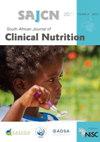Field-testing of food-based dietary guidelines
IF 0.8
Q4 NUTRITION & DIETETICS
引用次数: 1
Abstract
Food-based dietary guidelines (FBDGs) translate nutrition recommendations based on the best available scientific evidence into messages that are short, easy to understand, realistic and easy to apply in everyday settings. Development of the guidelines usually follows a structured and transparent process and applies methodology that balances rigour and pragmatism. The first phase in the development of FBDGs involves identification of (i) diet-health relationships, (ii) country specific diet-related health problems, (iii) nutrients of public health importance, (iv) foods relevant for FBDGs and (v) food consumption patterns. The developed FBDGs should then be tested and optimised, whereafter graphical illustrations of the guidelines should be developed. FBDGs provide a basis for public health programs and policies and are therefore country-specific, locally developed, and should be regularly revised. In instances where guidelines developed in one country are adapted to be used in other settings, cultural and social diversities as well as differences in dietary habits should be considered.以食物为基础的饮食指南的实地测试
以食物为基础的膳食指南(fbdg)将基于现有最佳科学证据的营养建议转化为简短、易于理解、现实和易于在日常环境中应用的信息。指南的制定通常遵循结构化和透明的过程,并采用平衡严谨和实用主义的方法。制定fbdg的第一阶段涉及确定(i)饮食与健康的关系;(ii)各国具体饮食相关的健康问题;(iii)对公共卫生具有重要意义的营养素;(iv)与fbdg有关的食物;(v)食物消费模式。然后,应对已制定的fbdg进行测试和优化,然后应制定准则的图形说明。fbdg为公共卫生规划和政策提供了基础,因此是针对具体国家、在当地制定的,应定期修订。在一个国家制定的准则经过调整以适用于其他环境的情况下,应考虑到文化和社会多样性以及饮食习惯的差异。
本文章由计算机程序翻译,如有差异,请以英文原文为准。
求助全文
约1分钟内获得全文
求助全文
来源期刊

South African Journal of Clinical Nutrition
NUTRITION & DIETETICS-
CiteScore
2.50
自引率
9.10%
发文量
21
期刊介绍:
1.The Journal accepts articles from all basic and applied areas of dietetics and human nutrition, including clinical nutrition, community nutrition, food science, food policy, food service management, nutrition policy and public health nutrition. 2.The Journal has a broad interpretation of the field of nutrition and recognizes that there are many factors that determine nutritional status and that need to be the subject of scientific investigation and reported in the Journal. 3.The Journal seeks to serve a broad readership and to provide information that will be useful to the scientific community, the academic community, government and non-government stakeholders in the nutrition field, policy makers and industry.
 求助内容:
求助内容: 应助结果提醒方式:
应助结果提醒方式:


